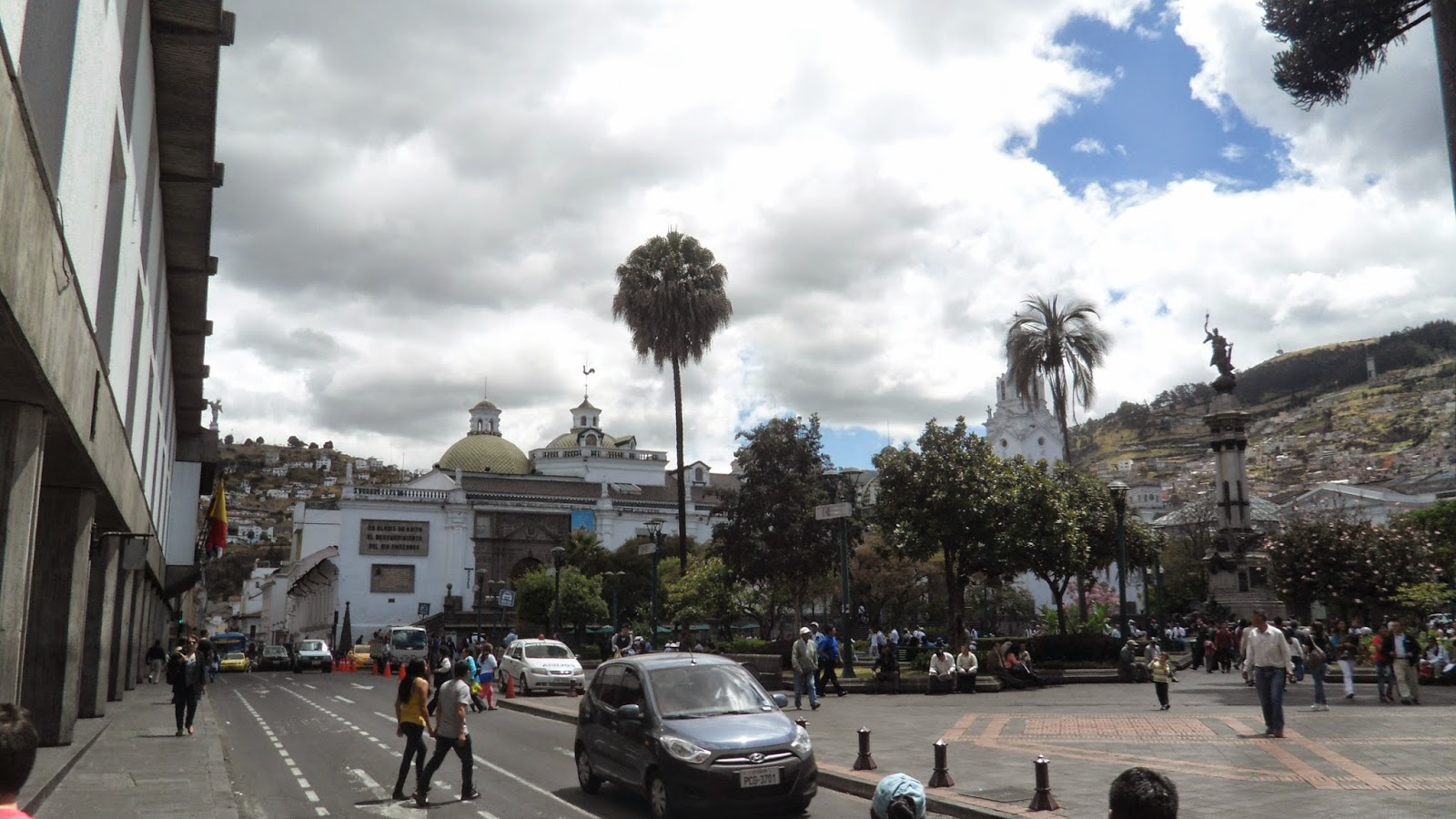I took the public transportation on my way there, which is an experience for itself. They're often packed, and once the doors open, both the passenger coming in and the one's going out rush the door. Not a nice experience, but it's probably due to a) the buses being packed, and b) the fact that the driver closes the door in a matter of seconds, regardless of whether there's still room in the bus or not. Maybe they're on a tight schedule...
 The old town, apart from the aforementioned religious architecture, is similar to other Latin American colonial towns that I've seen personally and in pictures, which I guess shouldn't surprise, seeing as they were built by the same colonizers. The old town is a pleasant place to walk around and hang out a bit (there were a lot of people just sort of hanging out). I didn't think it was anything spectactular, but maybe that's because I didn't go into the buildings. The only one I did go into was the basilica at the top of a hill (which I mistakenly took for the Cathedral). It was really impressive from the outside, a little less so from the inside.
The old town, apart from the aforementioned religious architecture, is similar to other Latin American colonial towns that I've seen personally and in pictures, which I guess shouldn't surprise, seeing as they were built by the same colonizers. The old town is a pleasant place to walk around and hang out a bit (there were a lot of people just sort of hanging out). I didn't think it was anything spectactular, but maybe that's because I didn't go into the buildings. The only one I did go into was the basilica at the top of a hill (which I mistakenly took for the Cathedral). It was really impressive from the outside, a little less so from the inside.Maybe I'll go back and see some more when my tandem partner, Nadine, arrives next week.

(PL)
Przedwczoraj wybrałem się do historycznego centrum, czyli do starego
miasta, które UNESCO wpisało na listę światowego dziedzictwa w samym
roku co krakowskie stare miasto. To chyba nie był przypadek, gdyż oba
miasta obfitują w klasztory i kościoły.
Jechałem komunikacją miejską, co było doświadczeniem samym w sobie.
Komunikacja jest często przepełniona, i kiedy otwierają się drzwi,
pasażerowie spieszą się do wyjścia i wejścia jednocześnie. To nie jest
miłe doświadczenie, lecz ma miejsce prawdopodobnie z dwóch powodów: a)
autobusy są przepełnione, i b) kierowca zamyka drzwi już po kilku
sekundach, obojętnie, czy jeszcze jest wolna przestrzeń w autobusie
czy nie. Przypuszczam, że mają ścisły rozkład jazdy…
Stare miasto, oprócz wcześniej wspomnianej religijnej architektury,
jest podobne to innych kolonialnych miast w Ameryce Łacińskiej, które
oglądałem osobiście i na zdjęciach. To nie powinno być zaskoczeniem
jako, że zostały one wszystkie zabudowane przez tych samych
kolonizatorów. Stare miasto w Quito jest przyjemnym miejscem do
spacerowania i ogólnie spędzania czasu (i właśnie było tam mnóstwo
ludzi po prosto siedzących i rozmawiających). Ja osobiście uważam, że
stare miasto nie jest niczym nadzwyczajnym, ale może to dlatego, że
(NIE?) wszedłem do środka budynków. Jedyny, którego zwiedziłem w
środku, to wielka bazylika na górze (myślałem mylnie, że to katedra).
Bazylika robi większe wrażenie na zewnątrz niż wewnątrz.
Może jeszcze wrócę i zwiedzę więcej, kiedy moja partnerka w projekcie, Nadine, przyleci.
miasta, które UNESCO wpisało na listę światowego dziedzictwa w samym
roku co krakowskie stare miasto. To chyba nie był przypadek, gdyż oba
miasta obfitują w klasztory i kościoły.
Jechałem komunikacją miejską, co było doświadczeniem samym w sobie.
Komunikacja jest często przepełniona, i kiedy otwierają się drzwi,
pasażerowie spieszą się do wyjścia i wejścia jednocześnie. To nie jest
miłe doświadczenie, lecz ma miejsce prawdopodobnie z dwóch powodów: a)
autobusy są przepełnione, i b) kierowca zamyka drzwi już po kilku
sekundach, obojętnie, czy jeszcze jest wolna przestrzeń w autobusie
czy nie. Przypuszczam, że mają ścisły rozkład jazdy…
Stare miasto, oprócz wcześniej wspomnianej religijnej architektury,
jest podobne to innych kolonialnych miast w Ameryce Łacińskiej, które
oglądałem osobiście i na zdjęciach. To nie powinno być zaskoczeniem
jako, że zostały one wszystkie zabudowane przez tych samych
kolonizatorów. Stare miasto w Quito jest przyjemnym miejscem do
spacerowania i ogólnie spędzania czasu (i właśnie było tam mnóstwo
ludzi po prosto siedzących i rozmawiających). Ja osobiście uważam, że
stare miasto nie jest niczym nadzwyczajnym, ale może to dlatego, że
(NIE?) wszedłem do środka budynków. Jedyny, którego zwiedziłem w
środku, to wielka bazylika na górze (myślałem mylnie, że to katedra).
Bazylika robi większe wrażenie na zewnątrz niż wewnątrz.
Może jeszcze wrócę i zwiedzę więcej, kiedy moja partnerka w projekcie, Nadine, przyleci.

No comments:
Post a Comment